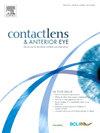利用数码成像技术优化评估撕裂半月板高度的方法。
IF 3.7
3区 医学
Q1 OPHTHALMOLOGY
引用次数: 0
摘要
目的:探讨利用数字成像技术评估撕裂半月板高度的最佳方法。方法:对38名参与者(平均年龄32.5±10.6岁,男性45%)的撕裂半月板进行3次视频记录,每次5秒,在两次自然眨眼后,使用5M眼眼角膜摄影仪,先用红外光,后用可见光(白光)拍摄。从录像中提取最后一次眨眼间隔0.5 s,最长5 s的静止图像,使用ImageJ在7个位置测量下眼睑撕裂半月板高度;紧接瞳孔中心下方,在鼻部和颞部1mm, 3mm和6mm处。用眼表疾病指数(OSDI)和泪膜稳定性(无创泪液破裂时间)评估干燥症状。结果:红外光测量撕裂半月板高度(0.29±0.08 mm)与白光测量撕裂半月板高度(0.27±0.08 mm)差异有统计学意义;结论:撕裂半月板高度测量应采用一致的方法,采用红外光或白光测量。从半月板顶部到距瞳孔中线1毫米以内的眼睑边缘,从两次眨眼后1.0到2.5秒的图像中进行一次测量就足够了。本文章由计算机程序翻译,如有差异,请以英文原文为准。
Optimising the methodology for assessing tear meniscus height using digital imaging
Purpose
To determine the optimum method for assessing tear meniscus height using digital imaging.
Method
The tear meniscus of 38 participants (mean age 32.5 ± 10.6 years, 45 % male) was video recorded three times, each for a period of five seconds following two natural blinks using the Oculus Keratograph 5M, first with infrared and subsequently with visible (white) light. Still images at 0.5 s intervals from the last blink, up to 5 s, were extracted from the video recording and the lower eyelid tear meniscus height was measured using ImageJ at seven locations; immediately below pupil centre and at 1 mm, 3 mm and 6 mm, nasally and temporally. Dryness symptoms were assessed with the Ocular Surface Disease Index (OSDI) and tear film stability with non-invasive tear breakup time with the Oculus Keratograph 5M.
Results
A significant difference in the tear meniscus height was measured with infrared (0.29 ± 0.08 mm) compared to white light (0.27 ± 0.08 mm; p < 0.001). Tear meniscus height increased significantly with repeated measurement (first: 0.27 ± 0.08 mm; second 0.27 ± 0.08; 0.28 ± 0.09; p = 0.005). In each case, following a significant decrease immediately after a blink, the tear meniscus height was stable between 1.0 and 2.5 s and increased thereafter (p < 0.001). A consistent tear meniscus height measurement was achieved by measuring within 1 mm of the pupil midline, but increased more peripherally (p < 0.001). Differences in height, while statistically significant, were not clinically significant except in the peripheral measurements.
Conclusion
Tear meniscus height should be measured in a consistent manner, either with infrared or white light. A single measurement from the top of the meniscus to the eyelid margin within 1 mm of the pupil midline, from an image captured 1.0 to 2.5 s after two blinks, is sufficient.
求助全文
通过发布文献求助,成功后即可免费获取论文全文。
去求助
来源期刊

Contact Lens & Anterior Eye
OPHTHALMOLOGY-
CiteScore
7.60
自引率
18.80%
发文量
198
审稿时长
55 days
期刊介绍:
Contact Lens & Anterior Eye is a research-based journal covering all aspects of contact lens theory and practice, including original articles on invention and innovations, as well as the regular features of: Case Reports; Literary Reviews; Editorials; Instrumentation and Techniques and Dates of Professional Meetings.
 求助内容:
求助内容: 应助结果提醒方式:
应助结果提醒方式:


